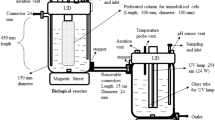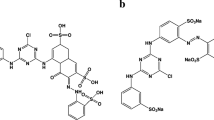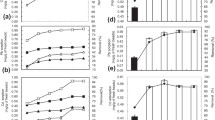Abstract
The mycelia of Trametes versicolor immobilized in alginate beads provided higher laccase production than that in pelleted form. An efficient ultrasonic treatment enhanced laccase production from the immobilized T. versicolor cultures. The optimized treatment process consisted of exposing 36-h-old bead cultures to 7-min ultrasonic treatments twice with a 12-h interval using a fixed ultrasonic power and frequency (120 W, 40 kHz). Using the intensification strategy with sonication, laccase production increased by more than 2.1-fold greater than the untreated control in both flasks and bubble column reactors. The enhancement of laccase production by ultrasonic treatment is related to the improved mass transfer of nutrients and product between the liquid medium and the gel matrix. These results provide a basis for the large-scale and highly-efficient production of laccase using sonobioreactors.










Similar content being viewed by others
Abbreviations
- C 0 :
-
Initial crystal violet concentration, μg/mL
- C t :
-
Dynamic (after adsorption for t time) crystal violet concentration, μg/mL
- m :
-
Weight of alginate beads, g
- V :
-
Solution volume of crystal violet, mL
- Q t :
-
Mass of crystal violet adsorbed at time t, μg/g wet gel
- Q e :
-
Mass of crystal violet adsorbed at equilibrium, μg/g wet gel
- K d :
-
Overall rate constant of adsorption, min−1
- t :
-
Reaction time, min
- TBA:
-
2-thiobarbituric acid
- TBARS:
-
TBA-reactive substances
References
Bajpai SK, Johnson S (2007) Removal of Cr(VI) oxy-anions from aqueous solution by sorption into poly(acrylamide-co-maleic acid) hydrogels. Sep Sci Technol 42:1049–1064
Baldrian P (2006) Fungal laccases—occurrence and properties. FEMS Microbiol Rev 30:215–242
Basto C, Silva CJ, Gubitz G, Cavaco-Paulo A (2007) Stability and decolourization ability of Trametes villosa laccase in liquid ultrasonic fields. Ultrason Sonochem 14:355–362
Birhanli E, Yesilada O (2006) Increased production of laccase by pellets of Funalia trogii ATCC 200800 and Trametes versicolor ATCC 200801 in repeated-batch mode. Enzyme Microb Technol 39:1286–1293
Bleve G, Lezzi C, Mita G, Rampino P, Perrotta C, Villanova L, Grieco F (2008) Molecular cloning and heterologous expression of a laccase gene from Pleurotus eryngii in free and immobilized Saccharomyces cerevisiae cells. Appl Microbiol Biotechnol 79:731–741
Bradford MM (1976) A rapid and sensitive method for quantitation of microgram quantities of protein utilizing the principle of protein-dye-binding. Anal Biochem 72:248–254
Brennan T, Frenkel C (1977) Involvement of hydrogen peroxide in the regulation of senescence in pear. Plant Physiol 59:411–416
Chisti Y (2003) Sonobioreactors: using ultrasound for enhanced microbial productivity. Trends Biotechnol 21:89–93
Couto SR, Sanroman MA, Hofer D, Gubitz GM (2004) Production of laccase by Trametes hirsuta grown in an immersion bioreactor and its application in the decolorization of dyes from a leather factory. Eng Life Sci 4:233–238
Deng CX, Sieling F, Pan H, Cui J (2004) Ultrasound-induced cell membrane porosity. Ultrasound Med Biol 30:519–526
Dominguez A, Gomez J, Lorenzo M, Sanroman A (2007) A enhanced production of laccase activity by Trametes versicolor immobilized into alginate beads by the addition of different inducers. World J Microbiol Biotechnol 23:367–373
Elstner EF, Heupel A (1976) Inhibition of nitrite formation from hydroxylammonium-chloride: a simple assay for superoxide-dismutase. Anal Biochem 70:616–620
Ganguly R, Dwivedi P, Singh RP (2007) Production of lactic acid with loofa sponge immobilized Rhizopus oryzae RBU2-10. Bioresour Technol 98:1246–1251
Gomez-Toribio V, García-Martín AB, Martínez MJ, Martínez AT, Guillen F (2009) Induction of extracellular hydroxyl radical production by white-rot fungi through quinone redox cycling. Appl Environ Microbiol 75:3944–3953
Grunwald P, Hansen K, Gunßer W (1997) The determination of effective diffusion coefficients in a polysaccharide matrix used for the immobilization of biocatalysts. Solid State Ion 101–103:863–867
Ha J, Engler CR, Lee SJ (2008) Determination of diffusion coefficients and diffusion characteristics for chlorferon and diethylthiophosphate in Ca-alginate gel beads. Biotechnol Bioeng 100:698–706
Hu XK, Zhao XH, Hwang HM (2007) Comparative study of immobilized Trametes versicolor laccase on nanoparticles and kaolinite. Chemosphere 66:1618–1626
Ismail NA, Annuar MSM, Ibrahim S (2011) Dye decolorization by immobilized laccase: statistical optimization and effect of impeller geometry. Int J Chem React Eng 9:1542–6580
Jirku V (1992) Permeabilization of covalently immobilized Saccharomyces cerevisiae. Acta Biotechnol 12:333–336
Jirku V (1996) The use of covalently immobilized mycelia to modify the β-glucanase system of Aspergillus vesicolor. J Chem Technol Biotechnol 65:179–185
Jung H, Xu F, Li KC (2002) Purification and characterization of laccase from wood-degrading fungus Trichophyton rubrum LKY-7. Enzyme Microb Technol 30:161–168
Kaluskar VM, Kapadnis BP, Jaspers C, Penninckx MJ (1999) Production of laccase by immobilized cells of Agaricus sp.: induction effect of xylan and lignin derivatives. Appl Biochem Biotechnol 76:161–170
Kilby NJ, Hunter CS (1990) Repeated harvest of vacuolelocated secondary products from in vitro grown plant cells using 1.02 MHz ultrasound. Appl Microbiol Biotechnol 33:448–451
Lateef A, Oke JK, Prapulla SG (2007) The effect of ultrasonication on the release of fructosyltransferase from Aureobasidium pullulans CFR 77. Enzyme Microb Technol 40:1067–1070
Li P, Wang HL, Liu GS, Li X, Yao JM (2011) The effect of carbon source succession on laccase activity in the co-culture process of Ganoderma lucidum and a yeast. Enzyme Microb Technol 48:1–6
Liu CZ, Wang F, Ou-Yang F (2009) Ethanol fermentation in a magnetically fluidized bed reactor with immobilized Saccharomyces cerevisiae in magnetic particles. Bioresour Technol 100:878–882
Liu R, Li W, Sun LY, Liu CZ (2012) Improving root growth and cichoric acid derivatives production in hairy root culture of Echinacea purpurea by ultrasound treatment. Biochem Eng J 60:62–66
Liu R, Liu Y, Liu CZ (2012) Development of an efficient CFD-simulation method to optimize the structure parameters of an airlift sonobioreactor. Chem Eng Res Des. doi:10.1016/j.cherd.2012.08.001
Liu ZY, Zhang DX, Hua ZZ, Li JH, Du GC, Chen J (2010) Improvement of laccase production and its properties by low-energy ion implantation. Bioprocess Biosyst Eng 33:639–646
Madrakian T, Afkhami A, Ahmadi M, Bagheri H (2011) Removal of some cationic dyes from aqueous solutions using magnetic-modified multi-walled carbon nanotubes. J Hazard Mater 196:109–114
Massalha N, Shaviv A, Sabbah I (2010) Modeling the effect of immobilization of microorganisms on the rate of biodegradation of phenol under inhibitory conditions. Water Res 44:5252–5259
Miller GL (1959) Use of dinitrosalicylic acid reagent for determination of reducing sugar. Anal Chem 31:426–428
Nakamura Y, Sungusia MG, Sawada T, Kuwahara M (1999) Lignin-degrading enzyme production by Bjerkandera adusta immobilized on polyurethane foam. J Biosci Bioeng 88:41–47
Neifar M, Jaouani A, Ellouze-Ghorbel R, Ellouze-Chaabouni S, Penninckx MJ (2009) Effect of culturing processes and copper addition on laccase production by the white-rot fungus Fomes fomentarius MUCL 35117. Lett Appl Microbiol 49:73–78
Osma JF, Moilanen U, Toca-Herrera JL, Rodriguez-Couto S (2011) Morphology and laccase production of white-rot fungi grown on wheat bran flakes under semi-solid-state fermentation conditions. FEMS Microbiol Lett 318:27–34
Ozbek B, Ulgen KO (2000) The stability of enzymes after sonication. Process Biochem 35:1037–1043
Papagianni M, Joshi N, Moo-Young M (2002) Comparative studies on extracellular protease secretion and glucoamylase production by free and immobilized Aspergillus niger cultures. J Ind Microbiol Biotechnol 29:259–263
Pilkington PH, Margaritis A, Mensour NA (1998) Mass transfer characteristics of immobilized cells used in fermentation processes. Crit Rev Biotechnol 18:237–255
Razmovski R, Vučurović V (2011) Ethanol production from sugar beet molasses by S. cerevisiae entrapped in an alginate-maize stem ground tissue matrix. Enzyme Microb Technol 48:378–385
Rodríguez Couto S, Sanromán MA, Hofer D, Gübitz GM (2004) Stainless steel sponge: a novel carrier for the immobilisation of the white-rot fungus Trametes hirsuta for decolourization of textile dyes. Bioresour Technol 95:67–72
Staszczak M, Zdunek E, Leonowicz A (2000) Studies on the role of proteases in the white-rot fungus Trametes versicolor: effect of PMSF and chloroquine on ligninolytic enzyme activity. J Basic Microbiol 40:51–63
Strong PJ, Claus H (2011) Laccase: a review of its past and its future in bioremediation. Crit Rev Environ Sci Technol 41:373–434
Sulaiman AZ, Ajit A, Yunus RM, Chisti Y (2011) Ultrasound-assisted fermentation enhances bioethanol productivity. Biochem Eng J 54:141–150
Susana RC, José LTH (2006) Industrial and biotechnological applications of laccases: a review. Biotechnol Adv 24:500–513
Susla M, Novotný C, Svobodová K (2007) The implication of Dichomitus squalens laccase isoenzymes in dye decolorization by immobilized fungal cultures. Bioresour Technol 98:2109–2115
Tezel A, Sens A, Mitragotri S (2002) A theoretical analysis of low-frequency sonophoresis: dependence of transdermal transport pathways on frequency and energy density. Pharm Res 19:1841–1846
Tinoco R, Acevedo A, Galindo E, Serrano-Carreón L (2011) Increasing Pleurotus ostreatus laccase production by culture medium optimization and copper/lignin synergistic induction. J Ind Microbiol Biotechnol 38:531–540
Wang F, Guo C, Wei T, Zhang T, Liu CZ (2012) Heat shock treatment improves Trametes versicolor laccase production. Appl Biochem Biotechnol 168:256–265
Wang F, Huang W, Guo C, Liu CZ (2012) Functionalized magnetic mesoporous silica nanoparticles: fabrication, laccase adsorption performance and direct laccase capture from Trametes versicolor fermentation broth. Bioresour Technol 126:117–122
Wang F, Ma AZ, Guo C, Zhuang GQ, Liu CZ (2013) Ultrasound-intensified laccase production from Trametes versicolor. Ultrason Sonochem 20:118–124
Wu JY, Ge XC (2004) Oxidative burst, jasmonic acid biosynthesis, and taxol production induced by low-energy ultrasound in Taxus chinensis cell suspension cultures. Biotechnol Bioeng 85:714–721
Wu YR, Luo ZH, Kwok-Kei Chow R, Vrijmoed LL (2010) Purification and characterization of an extracellular laccase from the anthracene-degrading fungus Fusarium solani MAS2. Bioresour Technol 101:9772–9777
Yen HW, Lee YC (2010) Production of lactic acid from raw sweet potato powders by Rhizopus oryzae immobilized in sodium alginate capsules. Appl Biochem Biotechnol 162:607–615
Acknowledgments
This work was financially supported by the National Basic Research Program (973 Program) of China (No. 2013CB733600), the National Key Technology Research and Development Program of China (No. 2012BAK25B01), the Bei**g Natural Science Foundation (No. 2102041), the National High Technology Research and Development Program (863 Program) of China (No. 2012AA101803), and the Knowledge Innovation Program of the Chinese Academy of Sciences (Nos. KSCX1-YW-11-D1 & KGCX2-YW-337). We acknowledge Dr. Amanda Stiles (the Chinese Academy of Sciences Fellowships for Young International Scientists, No. 2011Y1GA01) for the help in preparing the manuscript.
Author information
Authors and Affiliations
Corresponding author
Rights and permissions
About this article
Cite this article
Wang, F., Guo, C. & Liu, CZ. Immobilization of Trametes versicolor cultures for improving laccase production in bubble column reactor intensified by sonication. J Ind Microbiol Biotechnol 40, 141–150 (2013). https://doi.org/10.1007/s10295-012-1214-x
Received:
Accepted:
Published:
Issue Date:
DOI: https://doi.org/10.1007/s10295-012-1214-x




